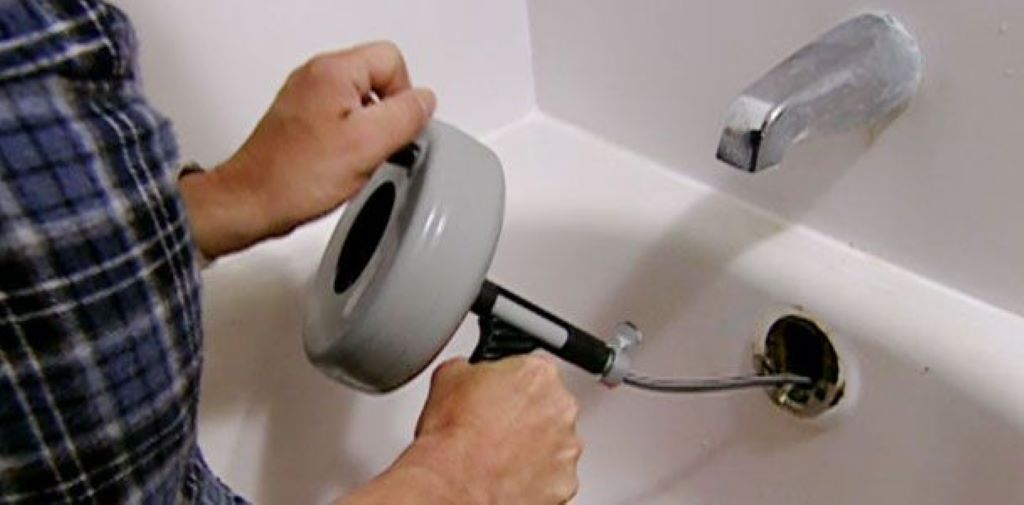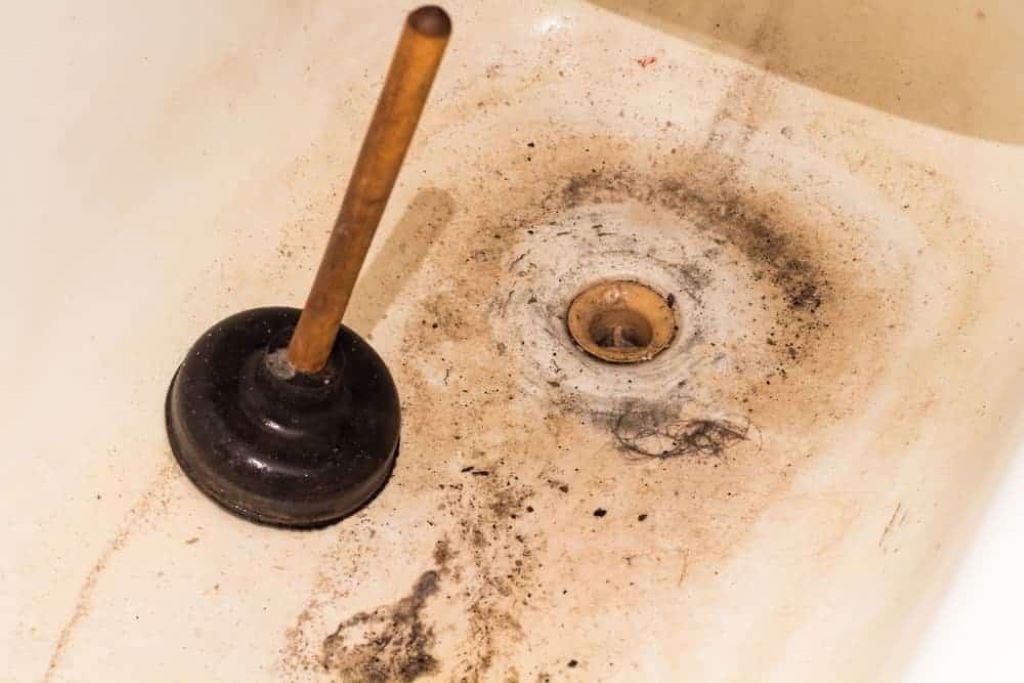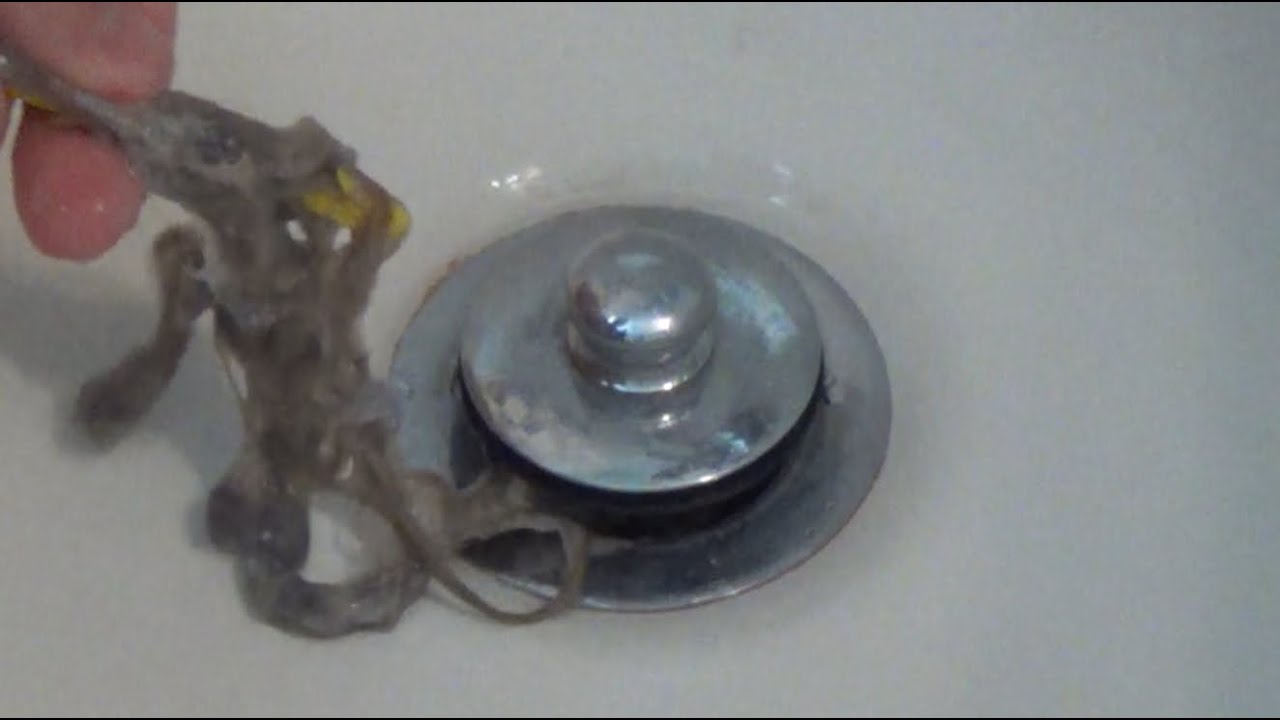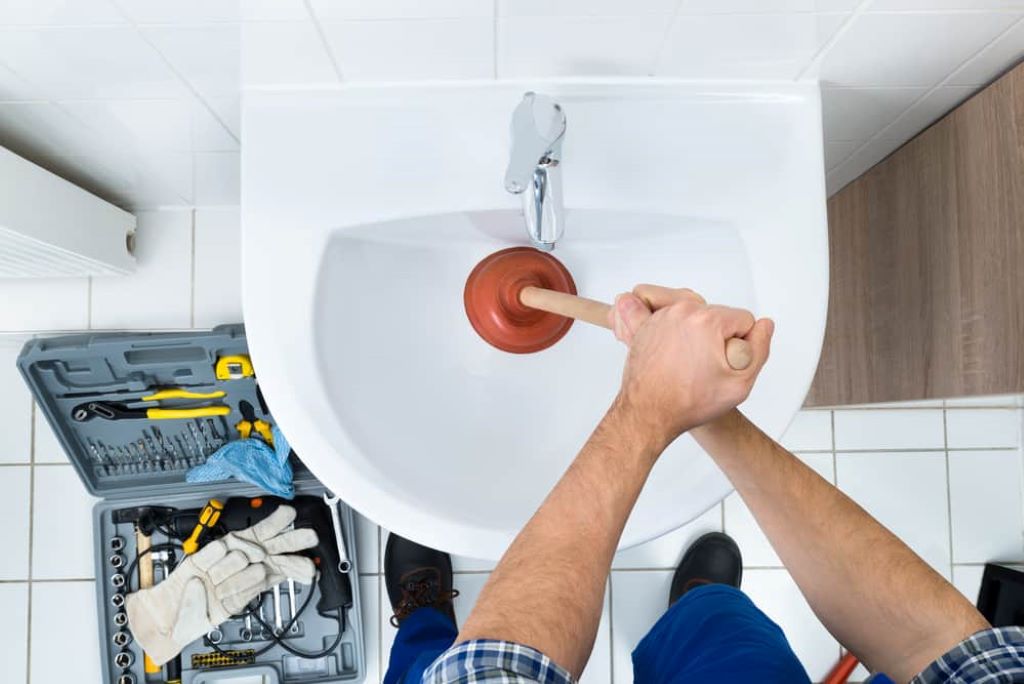A clogged bathtub drain can be one of the most annoying household problems. You’re just trying to take a relaxing bath at the end of a long day, but the water starts accumulating around your ankles because it’s draining too slowly. Or even worse – it’s not draining at all! While you could reach for harsh chemical drain cleaners, baking soda, and vinegar are safe, natural, and inexpensive ways to clear your bathtub drain. The chemical reaction between acid (vinegar) and base (baking soda) causes fizzing and bubbles when combined. The pressure that builds up can help dislodge gunk, soap scum, hair, and other debris that are blocking your drain.
Best of all, chances are you already have baking soda and vinegar in your pantry and fridge. There is no need to make a memorable trip to the store for supplies. Follow this step-by-step guide to clean a bathtub drain with this dynamic duo.
Why Drains Get Clogged in the First Place

Before jumping into the how-to, it helps to understand the most common causes of clogged drains so you can try to prevent these problems in the future:
- Soap scum buildup – Most bathtub and sink drains have a drain stopper that you manually close to allow water to accumulate in the basin. Each time you take a bath or wash your hands/dishes, a bit of soap scum sticks to the stopper. Over time, this can create a thick, gunky layer that blocks water flow.
- Hair and debris – Shedding hair and other debris like dirt, skin flakes, and fuzz from towels and washcloths can stick to soap scum on the stopper and pipes. Globs of this gunk eventually block the drain.
- Hard water deposits – If you live in an area with hard water, tiny mineral deposits can stick to pipes and accumulate over time. This limescale buildup eventually constricts water flow through pipes.
- Clogs in P-traps – Most drains have P-traps, the U-shaped bend in pipes designed to hold water and prevent sewer gas odors from entering the drain. Stuff that washes down the drain, like hair, food, and grease, can get caught in P-traps and cause clogging.
Regular drain maintenance is critical to preventing severe clogs. Discover how to remove bathtub drain efficiently. But even if you stay on top of it, clogs still happen! When they do, baking soda and vinegar are usually powerful enough to break through most bathtub drain clogs and get things flowing freely again.
How Does the Baking Soda and Vinegar Drain Cleaning Method Work?
Baking soda (sodium bicarbonate) is a mild base, and vinegar (acetic acid) is a mild acid. When you combine the two, an acidic chemical reaction releases carbon dioxide gas. This release of gas is critical for drain cleaning.
Here’s a closer look at the chemical reaction:
Baking soda (NaHCO3): sodium bicarbonate Vinegar (CH3COOH): acetic acid
Sodium bicarbonate + acetic acid –> sodium acetate + water + carbon dioxide
NaHCO3 + CH3COOH –> CH3COONa + H2O + CO2
The carbon dioxide gas that’s produced expands and bubbles up, providing pressure to help dislodge gunk and clogs in your drain pipe.
This is the same reaction that causes baked goods to rise when baking soda and vinegar are combined. But instead of air pockets in bread and cakes, it’s drain-cleaning bubbles!
Step-By-Step Instructions for How to Clean a Bathtub Drain with Baking Soda and Vinegar
Now that you understand why baking soda and vinegar make such an effective DIY drain cleaner let’s go through the simple process step-by-step:
What You’ll Need
- 1/2 cup baking soda
- 1 cup white vinegar (distilled vinegar works best)
- A sink or bucket larger than the drain opening
- A pot or kettle for boiling water
- A funnel (optional)
- Old rags
- Goggles for eye protection (optional but recommended)
- Rubber gloves (optional but recommended)
Step 1: Remove Drain Covering
Many bathtub drains have a decorative cover to remove to access the drain pipe opening. This cover is often held in place by a simple screw-on mechanism. Use a wrench or pliers to loosen and remove the screw.
Lift off the drain cover and set it aside someplace safe. You should now see a circular drain opening that leads down to the pipe. Remove any hair or debris that’s immediately visible.
Step 2: Flush with Boiling Water
Pour a pot or kettle of boiling water directly into the drain opening. This will help soften any grease or soap buildup so the baking soda and vinegar can work more effectively.
Allow the water to drain out completely. You may hear gurgling sounds as the hot water travels through the pipe.
Step 3: Pour Baking Soda Into the Drain
Measure 1/2 cup of baking soda and carefully pour it down the drain opening. If needed, you can use a funnel to guide it directly into the pipes.
The baking soda will sit in the drain trap and curved pipe section below. Even if standing water remains, the baking soda should stay in place for the next steps.
Step 4: Add Vinegar
Now, measure out 1 cup of white vinegar. Slowly pour it into the drain on top of the baking soda.
You’ll immediately see fizzing and bubbles when the vinegar hits the baking soda! This is the chemical reaction described earlier taking place.
The vinegar will cause the baking soda to expand and vigorously bubble, loosening clogs. Let the vinegar and baking soda break up the clog for 5-10 minutes. The fizzing bubbles will slowly subside.
Step 5: Boil More Water
While waiting for the baking soda and vinegar reaction to finish, boil another pot or kettle full of water.
Once the baking soda and vinegar have mostly finished reacting and draining away (about 10 minutes), carefully pour the fresh boiling water into the drain.
This gives a final flush to help wash away any grime and break things up further.
Step 6: Rinse and Run Clean Water
After pouring the boiling water, let the drain run for a few minutes under a stream of hot tap water. This rinses away any remaining vinegar or baking soda.
Plug the tub, fill it about 1 inch deep with plain hot water, and then unplug it to test drainage. The water should drain freely without any issues.
If it’s still draining slowly, you may need to repeat the process or try snaking the drain. Call a plumber for professional drain cleaning if DIY options don’t solve the clog.
Step 7: Replace Drain Cover
Once you’ve confirmed the drain is unclogged, replace the decorative drain cover and tighten the screw to hold it securely in place.
And that’s it! With this simple, safe, and affordable drain cleaning method, you’ll be back to relaxing bubble baths in no time.
Tips for Getting the Best Results
Here are some pointers for getting optimal results when using baking soda and vinegar to unclog drains:
- Use hot or boiling water when possible. Hot water will liquefy grease and soap buildup better than cold water.
- Let the baking soda and vinegar fully react and work on breaking up the clog for 5-10 minutes before rinsing. Don’t rush the chemical reaction.
- Ensure that any remaining baking soda and vinegar are thoroughly rinsed after the reaction. You don’t want any leftover particles clogging things up again.
- Plug the drain as the water rises after pouring in the boiling water. Let it fully cool before unplugging for a test drainage.
- Wear gloves and goggles since you’re working with hot liquids. Safety first!
- Repeat the process if needed for really stubborn clogs. It’s safe to do it multiple times.
- Try using a plunger before and after the baking soda and vinegar treatment to help dislodge the clog.
- Prevent future clogs by pouring 1/4 cup baking soda down the drain weekly and following with 1/4 cup vinegar. This maintains fresh pipes!
What Types of Clogs Can Baking Soda and Vinegar Fix?
This DIY drain cleaning method works on many types of bathtub clogs, including:
- Hair, soap scum, and gunk accumulating in the removable drain stopper
- Debris buildup in the drain trap (the U-shaped pipe curve below the drain opening)
- Partial blockages deeper in the drain pipe itself
- Minor hard water deposit blockages
- Grease or oil that has washed down the drain
However, baking soda and vinegar may be less effective for severe or profound blockages. Issues it likely won’t resolve include:
- Complete blockages far down the main sewer drain line beyond the traps.
- Tree roots grow into and crack pipes.
- A fully collapsed or damaged section of the drain pipe.
- Large objects like toys or washcloths stuck deep in the pipes.
- Significant calcium/limescale deposits in old pipes.
You’ll need a mechanical drain snake to break up the clog or professional drain cleaning services for issues like these. Calling a plumber for major drain repairs is also a good idea.
Still, baking soda and vinegar should be your go-to for minor to moderate bathtub drain clogs. When in doubt, it doesn’t hurt to try this method first since it’s affordable and safe for pipes.
What NOT To Do When Your Drain is Clogged
While the baking soda and vinegar method is generally safe, there are some things you should NOT do when trying to unclog a bathtub drain:
- Don’t use harsh chemical drain cleaners. They can damage pipes and be toxic if you get them on your skin. Stick to non-toxic options.
- Don’t immediately reach for a mechanical drain snake. Snakes can scratch porcelain finishes in bathtubs. Try baking soda and vinegar first.
- Don’t pull out hair from the drain with your fingers. Besides being gross, any hair left behind continues clogging the pipes.
- Don’t ignore a clogged shower drain. Letting a standing water pool can allow mold growth in your shower.
- Don’t pour grease or oil down the drain. Always collect and dispose of grease in the trash once cooled.
- Don’t use boiling water if you have PVC pipes. They can warp and be damaged.
Safe, non-toxic methods like baking soda and vinegar are always best for DIY drain cleaning. You avoid damaging pipes or coming into contact with harsh chemicals.
How Often Should You Use Baking Soda and Vinegar to Clean Drains?
For maintenance cleaning, you can pour a smaller amount of baking soda and vinegar down your drains about once a month to keep things flowing freely.
Use 1/4 cup baking soda followed by 1/4 cup vinegar for maintenance cleaning, waiting 5-10 minutes before rinsing with hot water.
Doing this monthly helps prevent soap scum and hair buildup, so you’re less likely to end up with a complete clog.
If your drains are moving slowly, do a complete strength treatment using 1/2 cup baking soda and 1 cup vinegar instead. Repeat as needed until fully unclogged. This can be done weekly if you have a recurring clog.
Natural Drain Cleaning Alternatives
While baking soda and vinegar are some of the most popular home remedies, there are a few other natural drain cleaning options:
Salt and Baking Soda – Mix equal parts salt and baking soda, about 1/2 cup each. Pour down the drain, sit for 5-10 minutes, and rinse. The grainy salt helps scrub away grime.
Salt and Vinegar – Pour 1/2 cup salt down the drain, followed by 1/2 cup vinegar instead of baking soda. Wait 10 minutes before rinsing.
Boiling Water – As mentioned above, boiling water alone can help liquefy fats and grease-clogging pipes. Feel free to repeat flushes of boiling water as needed when unclogging drains.
Baking Soda and Salt – Combine 1/4 cup baking soda with 1/4 cup salt. Pour down the drain, follow with a kettle of boiling water, and let sit overnight, if possible, before rinsing. The longer contact time allows it to work fully.
Enzyme Cleaners – Enzyme-based natural drain cleaners that use bacteria to break down organic gunk are available. Follow product instructions.

When to Call a Professional Plumber
While the baking soda and vinegar method works wonders for minor to moderate clogs, there are some instances where you may need to call in a professional:
- If DIY drains cleaning attempts, don’t unclog the drain.
- If the clog is in the main sewer line or septic tank, not just the tub drain itself.
- If you have a cracked, damaged, or collapsed drain pipe.
- If the drain pipes contain very stubborn hard water deposits or mineral buildup.
- If you need general drain repairs like fixing worn pipes or P-traps.
- If the clog was caused by children stuffing toys or large objects down the drain.
- If you don’t feel comfortable doing DIY drain cleaning for any reason.
Many plumbers even offer maintenance services like preventative drain cleaning to keep things flowing. Have an expert inspect tricky recurring clogs.
Don’t hesitate to call a pro if the baking soda and vinegar method didn’t do the trick. A mechanical drain snake is often required for severe main line clogs. And plumbing professionals have the right equipment for the job.
FAQs
How long does the baking soda and vinegar reaction last when cleaning drains?
The reaction lasts about 5-10 minutes with vigorous bubbling. Baking soda and vinegar batches react pretty quickly. Let it fully finish before rinsing.
What ratio of baking soda to vinegar should be used?
A typical bathtub drain cleaning recipe is 1/2 cup baking soda followed by 1 cup vinegar. However, equal amounts of both ingredients can also be adequate.
Is it better to use baking soda or vinegar first?
Pour the baking soda down the drain first, followed by the vinegar. If vinegar is poured first, the baking soda won’t stick to the pipes properly through standing water.
Can I use apple cider vinegar instead of white vinegar?
Yes, apple cider vinegar will work too! Any vinegar will trigger the reaction with baking soda.
Should boiling water be poured before or after the baking soda and vinegar?
Pour a first round of boiling water before to help soften soap scum. Then, pour another round after the reaction to help rinse away debris the fizzing loosened.
Why does my bathtub drain keep clogging after using baking soda and vinegar?
If it clogs again quickly, the drain likely needs a thorough deep cleaning with a mechanical snake to clear out the built-up gunk fully. Or there could be a more significant issue like mineral deposits or pipe damage.
The Takeaway
Hopefully, this gives you the confidence to banish bathtub drain clogs using items you already have in the pantry. When a drain starts slowing down, skip the harsh chemicals and reach for the dynamic duo of baking soda and vinegar instead.
With its fizzy reaction, baking soda and vinegar offer a safe, non-toxic solution for cleaning your bathroom sink drain. This dynamic duo effortlessly breaks up gunk, hair, grease, and more, sparing you from sticking your hands down the drain or dealing with pricey plumbing bills.
Stay on top of monthly maintenance cleaning and follow these steps when major clogs occur. Over time, you’ll get very familiar with timing the bubbly fizz – and your drains will stay clear for smooth water flow during relaxing bathtub soaks. No more standing in ankle-deep dirty water as the kids wait impatiently for their bath time!










